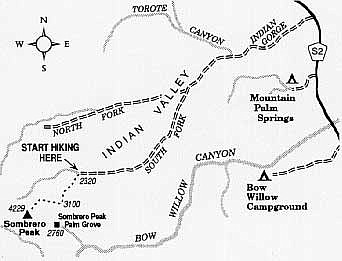 Facebook
Facebook
 X
X
 Instagram
Instagram
 TikTok
TikTok
 Youtube
Youtube
Sombrero Peak rises head and shoulders above the southern margins of the Anza-Borrego Desert, overlooking a hundred-square-mile expanse of rock-strewn mountains and gorges, sun-baked valleys, and distant badlands. Conversely, the peak itself is a prominent and familiar landmark -- with a sombrero profile -- widely visible from the desert floor below.
En route to Sombrero Peak
Climbing Sombrero Peak is a feat attempted by relatively few people, but not because of its height (4229 feet above sea level), which is quite modest. Rather, the peak is remote from paved roads, and its boulder-guarded flanks discourage those who are not willing to put up with either a long march to its base (from the west) or a shorter but sweaty eastern approach up from the desert floor. Sketched here is the shorter, eastern ascent -- only three miles round trip, but with 1900 feet of elevation gain. That three miles will take three hours at athletic-event speed and perhaps six hours at dilly-dally pace.
From Highway S-2 at mile 46.1, turn west onto a dirt road (suitable for all but low-slung cars) and drive through Indian Gorge. After 2.7 miles the road splits, with branches going into the north and south forks of Indian Valley. Keep left at this junction and drive into the south fork about three more miles to the road's end near the mouth of a canyon dotted with a few palms.
From the road's end, climb straight up the ridge to the south until you reach a flat at elevation 3100 feet. (As a side trip, you could traverse over to Sombrero Peak Palm Grove, a dense cluster of palms perched on a rocky slope high above the big canyon to the south -- Bow Willow Canyon.) Continue west, then southwest up the ridgeline to Sombrero's boulder-studded summit -- scrambling over modest-sized rocks most of the way, then over car-sized or larger boulders near the top.
On the summit, the best view is east, where Bow Willow Canyon and its tributaries yawn open in the blazing sun. On your way up, be sure to note your route so you can follow more or less the same route back down. Don't descend the peak on a route too far to the south; house-sized boulders and scratchy thickets of scrub oak will stop you then.


Sombrero Peak rises head and shoulders above the southern margins of the Anza-Borrego Desert, overlooking a hundred-square-mile expanse of rock-strewn mountains and gorges, sun-baked valleys, and distant badlands. Conversely, the peak itself is a prominent and familiar landmark -- with a sombrero profile -- widely visible from the desert floor below.
En route to Sombrero Peak
Climbing Sombrero Peak is a feat attempted by relatively few people, but not because of its height (4229 feet above sea level), which is quite modest. Rather, the peak is remote from paved roads, and its boulder-guarded flanks discourage those who are not willing to put up with either a long march to its base (from the west) or a shorter but sweaty eastern approach up from the desert floor. Sketched here is the shorter, eastern ascent -- only three miles round trip, but with 1900 feet of elevation gain. That three miles will take three hours at athletic-event speed and perhaps six hours at dilly-dally pace.
From Highway S-2 at mile 46.1, turn west onto a dirt road (suitable for all but low-slung cars) and drive through Indian Gorge. After 2.7 miles the road splits, with branches going into the north and south forks of Indian Valley. Keep left at this junction and drive into the south fork about three more miles to the road's end near the mouth of a canyon dotted with a few palms.
From the road's end, climb straight up the ridge to the south until you reach a flat at elevation 3100 feet. (As a side trip, you could traverse over to Sombrero Peak Palm Grove, a dense cluster of palms perched on a rocky slope high above the big canyon to the south -- Bow Willow Canyon.) Continue west, then southwest up the ridgeline to Sombrero's boulder-studded summit -- scrambling over modest-sized rocks most of the way, then over car-sized or larger boulders near the top.
On the summit, the best view is east, where Bow Willow Canyon and its tributaries yawn open in the blazing sun. On your way up, be sure to note your route so you can follow more or less the same route back down. Don't descend the peak on a route too far to the south; house-sized boulders and scratchy thickets of scrub oak will stop you then.
